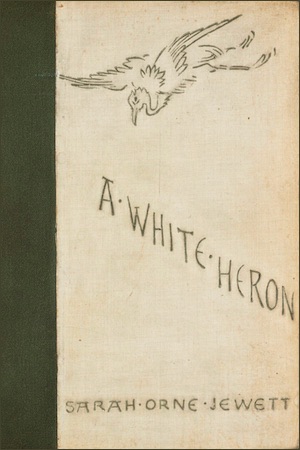
reactormag.com
Death Takes a Busman’s Holiday: Sarah Orne Jewett’s “The Gray Man”
Books
Reading the Weird
Death Takes a Busman’s Holiday: Sarah Orne Jewett’s “The Gray Man”
Horror has a surprising overlap with descriptions of gorgeous landscapes…
By Ruthanna Emrys, Anne M. Pillsworth
|
Published on August 14, 2024
Comment
0
Share New
Share
Welcome back to Reading the Weird, in which we get girl cooties all over weird fiction, cosmic horror, and Lovecraftiana—from its historical roots through its most recent branches. This week, we cover Sarah Orne Jewett’s “The Gray Man,” first published in Jewett’s A White Heron and Other Stories in 1886. Spoilers ahead!
High on the southern slope of Maine’s Mount Agamenticus stands an abandoned farm. Frost-shaken stone walls and a rubble-filling cellar are all that remain of the house, and the forest is quickly reclaiming its plot. At twilight an owl hoots from the hemlock, but few humans ever pass by. Most that do are repulsed by the farm’s loneliness. They shake their heads to think someone chose to live so far “from neighbors and from schools—yes, even from gossip and petty care of self or knowledge of the trivial fashions of a narrow life.” But those who appreciate the view of “the shining foreheads of the mountains” can understand and share a sense of “rest and benediction.”
Everywhere the place holds “a token of remembrance, of silence and secrecy.” Here “the stories of strange lives have been whispered to the earth,” and the earth awaits the return of the strong nature that once ruled it.
The farm’s first owner was a seafaring Scotsman who came ashore in his later years. When he died, the state took his unclaimed property, sold the one forest parcel worth anything, and left the rest to sun, rain and birds. The more the place decayed, the more people believed that an “uncanny existence” dwelt there. According, they shunned the farm.
Once, a Coastal Survey officer was curious enough to enter the house. He saw nothing alarming, but the voices of his companions outside seemed to fade away, and he sensed that an invisible inhabitant dogged him. He escaped to tell his tale, which over the years accrued greater terror as the townspeople passed it on. The supposedly revenant Scotsman was considered “accountable for deep offense” for having settled in “a place that escaped the properties and restraints of life upon lower levels.” Stray swamp lights frightened away any who ventured close, even as the world at large began to understand such phenomena. The townspeople might grow more familiar with the “visible world,” but “they grew more shy of the unseen and more sensitive to unexplained foreboding.”
One day a stranger passed through town on his way to settle at the haunted farm. He was tall and strongly built, but his face had a strange pallor and grayness, “as if he had been startled by bad news.” Even his eyes were faded. His clothing of homespun wool was of a gray little darker than his hair and skin. Yet for all his odd appearance and his suspicious choice of habitation, he was no hermit. There was “a sober cheerfulness about the man, as if he had known trouble and perplexity, and was fulfilling some mission that gave him pain; yet he saw some gain and reward beyond.” He befriended the farmers and their wives, proving himself a man of no common erudition by the advice he gave them. To promising children, he was an affectionate playmate; moreover, he taught their guardians “to recognize and further the true directions and purposes of existence” and pass them on to the young ones.
At first he was welcomed. It could be that some envious soul spoke against him, reminding his neighbors they knew nothing of his past, which if not exactly criminal must yet have been shocking. The real reason the people would eventually ostracize the gray man was that—he never smiled. For all his gentleness and good fellowship, once this peculiarity was noticed, who could joke around a fellow of such immovable sobriety? The children who at first would “prattle and play with him” would in time look into his face and then creep away. The breaking point came when the gray man attended a wedding and, as ever unsmiling, filled the other guests with such forebodings of sorrow for the newlyweds that the groom sent him out into the winter night “like a hunted creature.”
The gray man remained alone on his mountainside farm. Rare visitors told how he had beautified the place and how he had tamed the wild birds to come at his call. He remained ever ready to help his neighbors, but rumors of inhuman strength and knowledge widened the rift between them. Once, storm-beleaguered hunters spent a night in the gray man’s house. They said he never slept but sat reading one of his worn books by the fire. And in the dead of night, an empty chair glided over to him as he turned the pages.
When the “war of the rebellion” began, the gray man left his key with a neighbor as if going on a short journey. He never returned. Nearby villagers saw him striding off on the same road he’d come on, but another person saw him last. A farmer’s boy, wounded in one of the war’s first battles, glimpsed the gray man riding by on a tall horse. In his fear and pain, the boy thought “that Death himself rode by in the gray man’s likeness; unsmiling Death who tries to teach and serve mankind so that he may at the last win welcome as a faithful friend!”
What’s Cyclopean: “A strayaway blossom, some half-savage, slender grandchild of the old flower-plots”. Who says flowers have to be delicate?
Libronomicon: The Gray Man has three or four books, but we have no idea which ones. He’s so disturbing that no one has the guts to peruse his bookshelves.
Weirdbuilding: Stephen King isn’t the only author to find Maine inspiring.
Ruthanna’s Commentary
One of my favorite sub-sub-genres: Scary Thoreau! Horror has a surprising overlap with descriptions of gorgeous landscapes. “The Dunwich Horror” starts with my favorite Lovecraft line: “West of Arkham the hills rise wild”, and gorgeous birdsong. What birdwatcher doesn’t love a soul-hunting whippoorwill? “The Willows” brings readers deep into the lush flood of the Danube before anything even slightly supernatural occurs. My notes from That One Time Sam Talked Me Into Reading Twilight include a lot of questions about why Stephenie Meyer couldn’t just stick to describing the beauty of the Pacific rainforest.
Or maybe it’s not so surprising. Horror, after all, is a genre of mood and setting, much like nature writing. Their successes and failure modes are both dependent on close observation, and how well detail is linked to emotion. And shading from one into the other is an excellent way to have the supernatural creep into the natural. “The Gray Man” is a study in such transitions. Jewett moves easily from describing the Maine Hill Country to a particular ruin, from the ruin to the birth of urban legends around it, from legends to specific visitor, and from visitor back to urban legend again.
And for all that, it’s not clear that anything unusual has actually occurred. There’s a Scotsman who may or may not have buried ill-gotten treasure, the ruin of his house that may or may not be haunted, the unsmiling squatter who may or may not be Death Incarnate. Facts are short on the ground, but mood makes up for their lack entirely. If a creepy pub tale makes you shiver, do you really care whether there was a ghost, or an alien fungus, or a guy in a mask behind it?
Jewett’s Agementicus bears a subtler breed of disturbance than Lovecraft’s Arkham hills—largely because Jewett, while acknowledging the repulsion of a lonely ruin, also admits that a reasonable person might be drawn to such places as an alternative to “the trivial fashions of a narrow life”. The possibilities are broader where the people are fewer—in all sorts of directions.
What about the Gray Man himself? Let’s go with the idea that Death wanders the world providing much-needed guidance to farmers and cooks and parents—and hangs out unsmiling at weddings and feasts, a memento mori providing the least-desired insight to all present. Ought one refuse to invite him in, knowing that ultimately he won’t need an invitation? This seems suspiciously like failing to invite the wicked fairy to a christening. Then again, death probably has less ego in the game than your average fairy. He doesn’t exactly fade from existence, Tinkerbell-like, if you doubt his reality. There might be value in breaking bread with him, if only so that, when the time comes, you can remind him that a few more years would mean a few more loaves of that perfect sourdough.
Even the descriptions of the Gray Man are contradictory, legend-like. He might have strange powers, or not. He has a sober cheerfulness, and his eyes flash rage—but the expression on his face is “changeless.” The time period over which he goes from welcome to rejection is unclear, and might be weeks or months or even years. Only the Slaveholder’s Rebellion provides a clear marker, and that by itself isn’t enough to nail down his timeline in Maine—only to connect him to a larger set of stories.
Is Death drawn to the abandoned house because of its history? Is there a link between the “stronger nature” that once ruled the property, and the scar-like nature of the fallen foundations, and the guy who knows he’s not welcome closer to town? I can imagine Death wanting to live(?) in haunted places, comfortable among the ghosts and echoes. I can also imagine Death wanting to live(?) in places whose discomfiting stories match his own, even if there’s nothing to them other than the reality that humans make up patterns to try and make sense of him.
Anne’s Commentary
Jewett opens “The Gray Man” with three fulsome paragraphs describing her mountainside farm. Some might find this much detail about the setting excessive in a story so short; after all, isn’t it supposed to be about some gray guy? He doesn’t appear until paragraph six, when the 13-paragraph tale is practically half-over. And this is after two paragraphs about a mysterious Scottish seaman who turns out not to be the titular character.
There are good reasons for the relative weightiness of Jewett’s setting. I see specificity of place in fiction as a big plus. Not only does it firmly ground the reader, it can establish tone and atmosphere and even carry thematic significance. We know from sentence one exactly where the farm stands. A fictional setting (like King’s Jerusalem’s Lot or Lovecraft’s Dunwich) can achieve the density and color of an actual place, and why not, when it must to some extent stem from the author’s own memories and observations. But however she may adapt it to suit her story, Jewett’s setting is a real one.
Mt. Agamenticus is an elevation in the town of York, at the very southern tip of Maine. Being only 692 feet high, it’s really more of a hill. The technical term for a rise only notable because it juts out of comparatively flat terrain is a monadnock or inselberg. The first term derives from the Abenaki for an isolated hill, the second from the German for an “island mountain.” Agamenticus, now a nature park, was once an important landmark for sailors, and it’s supposed that the alleged Christian convert and martyr Mi’kmaq Chief Sachem Aspinquid was buried near its summit during a funeral attended by hundreds or even thousands of Native Americans and featuring the sacrifice of over 6700 animals. That’s if Aspinquid is not a legend. Anyway, he has a memorial cairn on Agamenticus.
It’s an interesting coincidence that in our current longread (Pet Sematary), Stephen King places a Mi’kmaq burial ground on a suddenish rise in the northeastern Maine woods. He uses the spelling Micmac, however. In the 1980s, scholarly publications and the media began using the spelling preferred by the Mi’kmaq nation, which considered “Micmac” to have a “colonial” taint.
Back to “The Gray Man.” How appropriate is it that Agamenticus hosted Aspinquid’s funeral? Particularly if there really were so many animals sacrificed—added to murdered Aspinquid, that’s death on a large enough scale to sanctify the place for Death His Own Self, I’d say.
Which is the big question “The Gray Man” poses. Is Gray (as I’ll call him henceforth) supposed to be the Big D? Two tropes occurred to me concerning his true nature. The first trope is “Death Takes a Holiday,” which supposes that Death wearies of His endless task of keeping down the world’s population and goes on leave. Generally, this means that everyone stops dying, though they don’t necessarily stop aging or reproducing or suffering from illness or accident, some highly undesirable consequences. It doesn’t seem that deaths are suspended while Gray occupies the Agamenticus farm, so he probably isn’t a vacationing Death per se.
The second trope is “Subbing for Death,” in which the Big D taps some poor slob to fill in while He’s on holiday. A subtrope could have Death deciding to teach a human lessons about mortality and/or the balance of nature and/or carpe diem and all that jazz by putting them in charge of the scythe for a while. This subtrope may apply to Gray in that he has certainly amassed enough knowledge about life and death to be both perpetually sobered yet eager to share his wisdom with less far-sighted mortals.
Another subtrope is “How Can There Be Only One Grim Reaper When There’s So Much Reaping to Do?” Say the Big D recruits a whole civil service of Reapers from among mortals, maybe with the lure of personal immortality. Reaping could quickly wear on a person. Reaping forever? That’d likely turn a person, however immortal, every possible shade of gray. Sometimes, when there are fewer sheaves to cut, the Big-D might give His subordinates a break. A vacationing Reaper might gravitate toward a solitary retreat, given their repulsive effects on neighbors. At the same time, a Reaper grown compassionate toward their “crop” might want folks around to teach that in the end “unsmiling Death” is “a faithful friend.”
From the way the farm thrives under Gray, this is a lesson birds and plants and the earth itself are quicker to accept than humans. But he perseveres even after he gets kicked out of the wedding feast (shades of the Ancient Mariner!) and subsequently out of the Agamenticus community. It’s a good thing he has that ghostly Scotsman to draw up a chair to his lonely fireside.
Gray’s vacation must end eventually, because there are always new wars and epidemics and natural disasters to call all Reapers to active duty. As the Civil War commences, Gray disappears from Agamenticus. Later a wounded soldier sees Gray ride by on a tall horse and believes him to be Death Himself.
No. Death Himself gets the pale horse. His underlings must take whatever apocalyptic nags are left over.
Next week, Jud explains things (some of them) in Chapter 26 of Pet Sematary.[end-mark]
The post Death Takes a Busman’s Holiday: Sarah Orne Jewett’s “The Gray Man” appeared first on Reactor.

















